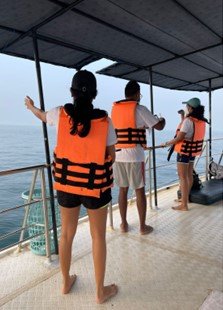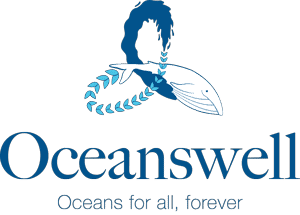Written by Ayani Nagahawatte
Why I applied
Biology is a subject I’ve always been interested in. From microorganisms to giant blue whales, all kinds of life, to me, are a wonderful creation of mother nature and the oceans are the most mysterious of them. My curiosity to know more about the ocean and marine life led me to this volunteer internship at Oceanswell so that I could contribute towards creating a bigger impact on marine conservation and protection.
My role in the team
As a volunteer intern, my role in the team was not limited to a specific task. It included a wide range of tasks including fieldwork and office work. Fieldwork was the most exciting because we got to see miracles with our own eyes. In the field, my role included spotting marine mammals, collecting data and entering data into the datasheets. On the other hand, office work is where we find ways to share those miraculous encounters with the rest of the world, organise and analyse the data we collect, share knowledge, and help conservation, which is just as exciting as being in the field!
The data we collected and their importance
We have four datasheets on board; an effort sheet, a weather datasheet, boat observation, and blow datasheet. A team member is usually in charge of each datasheet. Since we had four members in our team, one had to be in charge of boat observation and weather datasheets at the same time. Dr. Asha’s role was to take photographs for photo identification. We were placed on the 4 ends of the boat so that we could cover as much of the surroundings as possible. The boat crew helped us out as well. We carefully observed until we spotted an animal. We look for splashes, a blow or a dorsal fin. If it is a turtle, its shell would be the first thing we see. Once we see one of those signs, we call the rest of the team to confirm our sighting. Sometimes it’s a sighting of an animal, but sometimes it’s just the whitecaps or a log that is floating. Either way, it is always better to confirm with the team.
The effort sheet is the most important of all. It acts like a log entry that records everything we do in the field. It starts with the start time which we record as “START”. Then we record each weather point as “WR”. Each sighting gets a CO number (CO stands for confirmed observation). When a whale is encountered all our eyes are on that animal, which means we would not notice if there was another animal at a distance. Hence we go off effort (that is recorded as “OE” on the sheet). When we are back on effort we record that as “SE” for search effort. If we get lucky we might collect poo samples and that is recorded as “PC” (poo collection) and if we are collecting acoustic data that will be recorded as “AC”. Lastly, we record the end time as “END”. Whoever is in charge of the effort sheet, carries a compass and a GPS, and takes the waypoints (GPS locations!). Upon sighting an individual a waypoint is taken and the estimated distance and angle to the animal is recorded.

The weather sheet is also an important datasheet. It gives us an idea of how the weather was on that day and how it affected our fieldwork. For example, we collect data on the sea state. This indicates how rough the sea is (sea state 0 is calm glassy sea, 1 is calm rippled sea and etc. ) It really matters because when the waves are bigger it’s hard to see movements at a distance, and the white caps make it harder to spot splashes..
The boat observation sheet collects data about the number of boats, the type of boats (whale watching boats, coast guard boats or container ships) within a 50m,100m and 500m radius and how the animals’ behavior is affected by the boats.
The blow data sheet is only taken out in the presence of a whale. As soon as we encounter a whale we start collecting blow data. A blow is a visible gust of water that is created when a whale exhales. If we are close enough we can even hear them! Whales blow multiple times in one blow cycle before they take one deep breath and dive deep. We note down the number of blows and the exact times. This data helps us to get an idea about how long it takes between two blow cycles, and even allows us to compare how their breathing is affected by the number of boats around them.
The lessons we learned from the ocean
Not everyday was full of sightings, there were days that all we did was stare at the ocean hoping an animal would appear. There were also days that the sea was too rough for us to spot an animal. However, even on those days, there was always something for us to learn. Being on the ocean itself made us feel so small; we are just a tiny dot compared to the ocean! And no matter how prepared we are, what could happen is totally out of our control. That made us feel humble. Patience and vigilance, to me, were the most important qualities we practised during fieldwork. We were taught to expect the unexpected. Because sometimes the sea is calm in the beginning but turns rough by the end, or starts raining out of nowhere. I think there is beauty in that unpredictability and uncontrollability, in nature being itself!
